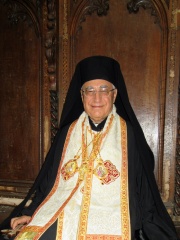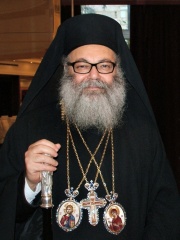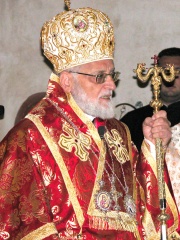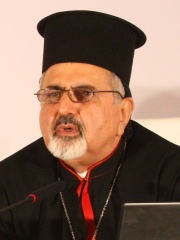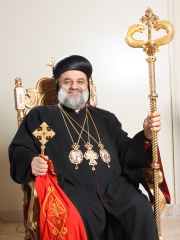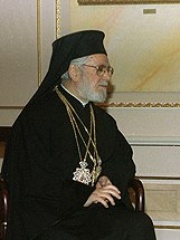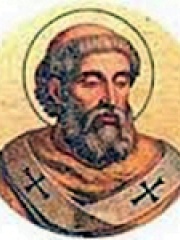
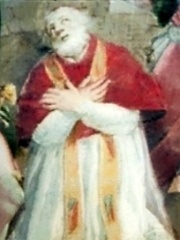
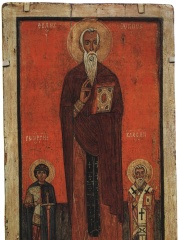


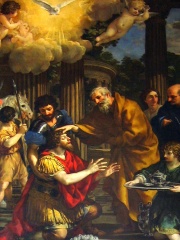
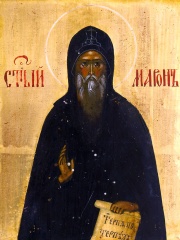

The Most Famous
RELIGIOUS FIGURES from Syria
This page contains a list of the greatest Syrian Religious Figures. The pantheon dataset contains 3,187 Religious Figures, 25 of which were born in Syria. This makes Syria the birth place of the 20th most number of Religious Figures behind Switzerland, and China.
Top 10
The following people are considered by Pantheon to be the top 10 most legendary Syrian Religious Figures of all time. This list of famous Syrian Religious Figures is sorted by HPI (Historical Popularity Index), a metric that aggregates information on a biography's online popularity. Visit the rankings page to view the entire list of Syrian Religious Figures.

1. Pope Gregory III (700 - 741)
With an HPI of 79.99, Pope Gregory III is the most famous Syrian Religious Figure. His biography has been translated into 79 different languages on wikipedia.
Pope Gregory III (Latin: Gregorius III; died 28 November 741) was the bishop of Rome from 11 February 731 to his death on 28 November 741. His pontificate, like that of his predecessor, was disturbed by Byzantine iconoclasm and the advance of the Lombards, in which he invoked the intervention of Charles Martel, although ultimately in vain. He was the last pope to seek the consent of the Byzantine exarch of Ravenna for his election, the last pope of Syrian origin, and the last pope born outside Europe until the election of Pope Francis 1,272 years later in 2013.

2. Pope Anicetus (70 - 168)
With an HPI of 77.69, Pope Anicetus is the 2nd most famous Syrian Religious Figure. His biography has been translated into 74 different languages.
Pope Anicetus (Greek: Ανίκητος) was the bishop of Rome from c. 157 to his death in April 168. According to the Annuario Pontificio, the start of his papacy may have been 153. Anicetus actively opposed Gnosticism and Marcionism. He welcomed Polycarp of Smyrna to Rome to discuss the Easter controversy.

3. John Climacus (579 - 649)
With an HPI of 73.89, John Climacus is the 3rd most famous Syrian Religious Figure. His biography has been translated into 35 different languages.
John Climacus (Ancient Greek: Ἰωάννης τῆς Κλίμακος; Latin: Ioannes Climacus; Arabic: يوحنا السلمي, romanized: Yuḥana al-Sêlmi), also known as John of the Ladder, John Scholasticus and John Sinaites, was a 6th–7th century Christian monk at the monastery on Mount Sinai. He is revered as a saint by the Eastern Orthodox Church and Catholic Church.

4. Ibn Qayyim al-Jawziyya (1292 - 1350)
With an HPI of 70.56, Ibn Qayyim al-Jawziyya is the 4th most famous Syrian Religious Figure. His biography has been translated into 30 different languages.
Shams ad-Dīn ʾabū ʿAbd Allāh Muḥammad ibn ʾAbī Bakr ibn ʾAyyūb az-Zurʿī ad-Dimashqī al-Ḥanbalī (29 Jan. 1292–15 Sep. 1350 CE / 691–751 AH), commonly known as Ibn Qayyim al-Jawziyyah ("The son of the principal of [the school of] Jawziyyah") or Ibn al-Qayyim ("Son of the principal"; ابن القيّم) for short, or reverentially as al-Imam Ibn al-Qayyim in Sunni tradition, was an important medieval Islamic jurisconsult, theologian, and spiritual writer. Belonging to the Hanbali school of Fiqh (Islamic Jurisprudence), of which he is regarded as "one of the most important thinkers," Ibn al-Qayyim was also the foremost disciple and student of Ibn Taymiyyah, with whom he was imprisoned in 1326 for dissenting against established tradition during Ibn Taymiyyah's famous incarceration in the Citadel of Damascus. Of humble origin, Ibn al-Qayyim's father was the principal (qayyim) of the School of Jawziyyah, which also served as a court of law for the Hanbali judge of Damascus during the period. Ibn al-Qayyim went on to become a prolific scholar, producing a rich corpus of "doctrinal and literary" works. As a result, numerous important Muslim scholars of the Mamluk period were among Ibn al-Qayyim's students or, at least, greatly influenced by him, including, amongst others, the Shafi historian Ibn Kathir (d. 774/1373), the Hanbali hadith scholar Ibn Rajab (d. 795/1397) and Ibn Hajar al-Asqalani (d. 852/1449). In the present day, Ibn al-Qayyim's name has become a controversial one in certain quarters of the Islamic world due to his popularity amongst many adherents of Salafism, who see in his criticisms of such widespread Sufi practices of the medieval period associated with veneration of saints and the veneration of their graves and relics a classical precursor to their own perspective.
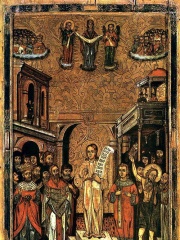
5. Romanos the Melodist (490 - 556)
With an HPI of 69.91, Romanos the Melodist is the 5th most famous Syrian Religious Figure. His biography has been translated into 33 different languages.
Romanos the Melodist (Greek: Ῥωμανὸς ὁ Μελωδός; late 5th-century – after 555) was a Byzantine hymnographer and composer, who is a central early figure in the history of Byzantine music. Called "the Pindar of rhythmic poetry", he flourished during the sixth century, though the earliest manuscripts of his works are dated centuries after this. He was the foremost Kontakion composer of his time.

6. Émile Benveniste (1902 - 1976)
With an HPI of 69.73, Émile Benveniste is the 6th most famous Syrian Religious Figure. His biography has been translated into 35 different languages.
Émile Benveniste (French: [emil bɛ̃venist]; 27 May 1902 – 3 October 1976) was an Ottoman-born French structural linguist and semiotician. He is best known for his work on Indo-European languages and his critical reformulation of the linguistic paradigm established by Ferdinand de Saussure.

7. Ananias of Damascus (100 - 100)
With an HPI of 69.72, Ananias of Damascus is the 7th most famous Syrian Religious Figure. His biography has been translated into 28 different languages.
Ananias of Damascus ( AN-ə-NY-əs; Ancient Greek: Ἀνανίας, romanized: Ananíās; Aramaic: ܚܢܢܝܐ, romanized: Ḥananyō; "favoured of the LORD") was a disciple of Jesus in Damascus, mentioned in the Acts of the Apostles in the Bible, which describes how he was sent by Jesus to restore the sight of Saul of Tarsus (who later was called Paul the Apostle) and provide him with additional instruction in the way of the Lord.

8. Maron (301 - 410)
With an HPI of 68.60, Maron is the 8th most famous Syrian Religious Figure. His biography has been translated into 28 different languages.
Maron, also called Maroun or Maro (Syriac: ܡܪܘܢ, Mārōn; Arabic: مَارُون, Mārūn; Latin: Maron; Ancient Greek: Μάρων), was a 4th-century Syriac Christian hermit monk in the Taurus Mountains whose followers, after his death, founded a religious Christian movement that became known as the Maronite Church, in full communion with the Holy See and the Catholic Church. The religious community which grew from this movement are the modern Maronites. Maron, revered as a highly spiritual ascetic monk with a connection to God through his communion with the natural environment, garnered widespread respect within Christian circles. In addition to his emphasis on ascetic spirituality, he played an important role in advancing Christian missions in the region. One of his disciples, Abraham of Cyrrhus, emerged as a missionary, successfully disseminating the Maronite variant of Christianity in Lebanon, which took root in the region and persisted ever since. Saint Maron is often portrayed in a black monastic habit with a hanging stole, accompanied by a long crosier staffed by a globe surmounted with a cross. His feast day in the Maronite Church is February 9.

9. Apollinaris of Laodicea (310 - 390)
With an HPI of 67.99, Apollinaris of Laodicea is the 9th most famous Syrian Religious Figure. His biography has been translated into 31 different languages.
Apollinaris the Younger, also known as Apollinaris of Laodicea and Apollinarius (Ancient Greek: Ἀπολλινάριος; died 382), was a bishop of Laodicea in Syria. He is best known as a noted opponent of Arianism. Apollinaris's eagerness to emphasize the deity of Jesus and the unity of his person led him to deny the existence of a rational human soul in Christ's human nature. This view came to be called Apollinarism. It was condemned by the First Council of Constantinople in 381.
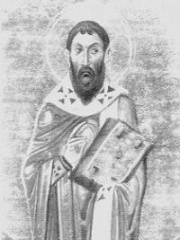
10. Sophronius of Jerusalem (560 - 638)
With an HPI of 66.98, Sophronius of Jerusalem is the 10th most famous Syrian Religious Figure. His biography has been translated into 30 different languages.
Sophronius (Ancient Greek: Σωφρόνιος; Arabic: صفرونيوس; c. 560 – 11 March 638), called Sophronius the Sophist, was the Greek Orthodox Patriarch of the city known as Aelia Capitolina and then Jerusalem from 634 until his death. He is venerated as a saint in the Eastern Orthodox and Catholic Churches. Before rising to the primacy of the See, he was a monk and theologian who was the chief protagonist for orthodox teaching in the doctrinal controversy on the essential nature of Jesus and his volitional acts. He is also renowned for the negotiation of the surrender of Aelia Capitolina to the Rashid caliph Umar in 637/8.
People
Pantheon has 25 people classified as Syrian religious figures born between 70 and 1977. Of these 25, 5 (20.00%) of them are still alive today. The most famous living Syrian religious figures include Youssef Absi, John X of Antioch, and Gregory III Laham. The most famous deceased Syrian religious figures include Pope Gregory III, Pope Anicetus, and John Climacus.
Living Syrian Religious Figures
Go to all RankingsYoussef Absi
1946 - Present
HPI: 65.92
John X of Antioch
1955 - Present
HPI: 63.92
Gregory III Laham
1933 - Present
HPI: 63.03
Ignatius Joseph III Yonan
1944 - Present
HPI: 61.18
Ignatius Aphrem II
1965 - Present
HPI: 60.08
Deceased Syrian Religious Figures
Go to all RankingsPope Gregory III
700 - 741
HPI: 79.99
Pope Anicetus
70 - 168
HPI: 77.69
John Climacus
579 - 649
HPI: 73.89
Ibn Qayyim al-Jawziyya
1292 - 1350
HPI: 70.56
Romanos the Melodist
490 - 556
HPI: 69.91
Émile Benveniste
1902 - 1976
HPI: 69.73
Ananias of Damascus
100 - 100
HPI: 69.72
Maron
301 - 410
HPI: 68.60
Apollinaris of Laodicea
310 - 390
HPI: 67.99
Sophronius of Jerusalem
560 - 638
HPI: 66.98
Gregory Peter XX Ghabroyan
1934 - 2021
HPI: 64.25
Ignatius IV of Antioch
1920 - 2012
HPI: 64.07
Overlapping Lives
Which Religious Figures were alive at the same time? This visualization shows the lifespans of the 7 most globally memorable Religious Figures since 1700.

